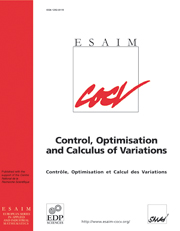Crossref Citations
This article has been cited by the following publications. This list is generated based on data provided by
Crossref.
Vermaak, Natasha
Michailidis, Georgios
Parry, Guillaume
Estevez, Rafael
Allaire, Grégoire
and
Bréchet, Yves
2014.
Material interface effects on the topology optimizationof multi-phase structures using a level set method.
Structural and Multidisciplinary Optimization,
Vol. 50,
Issue. 4,
p.
623.
Allaire, G.
Dapogny, C.
and
Frey, P.
2014.
Shape optimization with a level set based mesh evolution method.
Computer Methods in Applied Mechanics and Engineering,
Vol. 282,
Issue. ,
p.
22.
Mirzendehdel, Amir M.
and
Suresh, Krishnan
2015.
A Pareto-Optimal Approach to Multimaterial Topology Optimization.
Journal of Mechanical Design,
Vol. 137,
Issue. 10,
Liu, Jikai
Ma, Yongsheng
Fu, Junyu
and
Duke, Kajsa
2015.
A novel CACD/CAD/CAE integrated design framework for fiber-reinforced plastic parts.
Advances in Engineering Software,
Vol. 87,
Issue. ,
p.
13.
Allaire, G.
and
Delgado, G.
2016.
Stacking sequence and shape optimization of laminated composite plates via a level-set method.
Journal of the Mechanics and Physics of Solids,
Vol. 97,
Issue. ,
p.
168.
Feppon, Florian
Sidebottom, Mark A.
Michailidis, Georgios
Krick, Brandon A.
and
Vermaak, Natasha
2016.
Efficient Steady-State Computation for Wear of Multimaterial Composites.
Journal of Tribology,
Vol. 138,
Issue. 3,
Cai, Kun
Cao, Jing
Shi, Jiao
and
Qin, Qing H.
2016.
Layout Optimization of Ill-Loaded Multiphase Bi-Modulus Materials.
International Journal of Applied Mechanics,
Vol. 08,
Issue. 03,
p.
1650038.
Blank, Luise
Garcke, Harald
Hecht, Claudia
and
Rupprecht, Christoph
2016.
Sharp Interface Limit for a Phase Field Model in Structural Optimization.
SIAM Journal on Control and Optimization,
Vol. 54,
Issue. 3,
p.
1558.
Cao, Jing
Cai, Kun
Wang, Peng Fei
Yan, Dong
and
Shi, Jiao
2016.
Multiple materials layout optimization in a layered structure.
Mechanics & Industry,
Vol. 17,
Issue. 4,
p.
404.
Cui, Mingtao
Chen, Hongfang
and
Zhou, Jingling
2016.
A level-set based multi-material topology optimization method using a reaction diffusion equation.
Computer-Aided Design,
Vol. 73,
Issue. ,
p.
41.
Allaire, Grégoire
Jouve, François
and
Michailidis, Georgios
2016.
Variational Analysis and Aerospace Engineering.
Vol. 116,
Issue. ,
p.
1.
NOGUCHI, Yuki
YAMADA, Takayuki
YAMAMOTO, Takashi
IZUI, Kazuhiro
and
NISHIWAKI, Shinji
2016.
Topological derivative for an acoustic-elastic coupled system based on two-phase material model.
Mechanical Engineering Letters,
Vol. 2,
Issue. 0,
p.
16-00246.
Liu, Jikai
Duke, Kajsa
and
Ma, Yongsheng
2016.
Multi-material plastic part design via the level set shape and topology optimization method.
Engineering Optimization,
Vol. 48,
Issue. 11,
p.
1910.
Myśliński, Andrzej
2016.
System Modeling and Optimization.
Vol. 494,
Issue. ,
p.
380.
Shi, Jiao
Cao, Jing
Cai, Kun
Wang, Zhenzhong
and
Qin, Qing-Hua
2016.
Layout optimization for multi-bi-modulus materials system under multiple load cases.
Engineering with Computers,
Vol. 32,
Issue. 4,
p.
745.
Myslinski, Andrzej
and
Koniarski, Konrad
2016.
Sharp interface limit in phase-field based structural optimization of variational inequalities.
p.
225.
Erickson, Gregory M
Sidebottom, Mark A
Curry, John F
Ian Kay, David
Kuhn-Hendricks, Stephen
Norell, Mark A
Gregory Sawyer, W
and
Krick, Brandon A
2016.
Paleo-tribology: development of wear measurement techniques and a three-dimensional model revealing how grinding dentitions self-wear to enable functionality.
Surface Topography: Metrology and Properties,
Vol. 4,
Issue. 2,
p.
024001.
Wang, Yu
Luo, Zhen
Zhang, Nong
and
Wu, Tao
2016.
Topological design for mechanical metamaterials using a multiphase level set method.
Structural and Multidisciplinary Optimization,
Vol. 54,
Issue. 4,
p.
937.
Schmitt, Oliver
Friederich, Jan
Riehl, Stefan
and
Steinmann, Paul
2016.
On the formulation and implementation of geometric and manufacturing constraints in node–based shape optimization.
Structural and Multidisciplinary Optimization,
Vol. 53,
Issue. 4,
p.
881.
Allaire, G.
Jouve, F.
and
Michailidis, G.
2016.
Thickness control in structural optimization via a level set method.
Structural and Multidisciplinary Optimization,
Vol. 53,
Issue. 6,
p.
1349.




